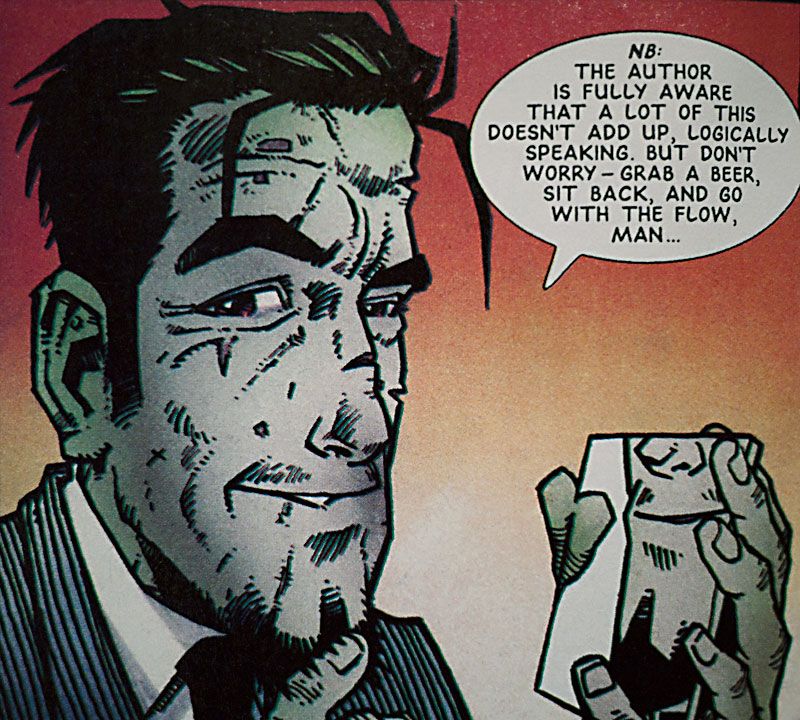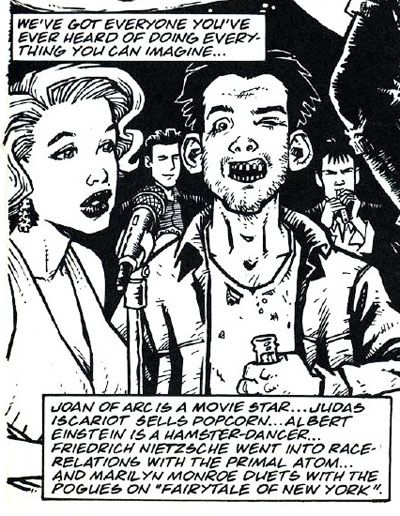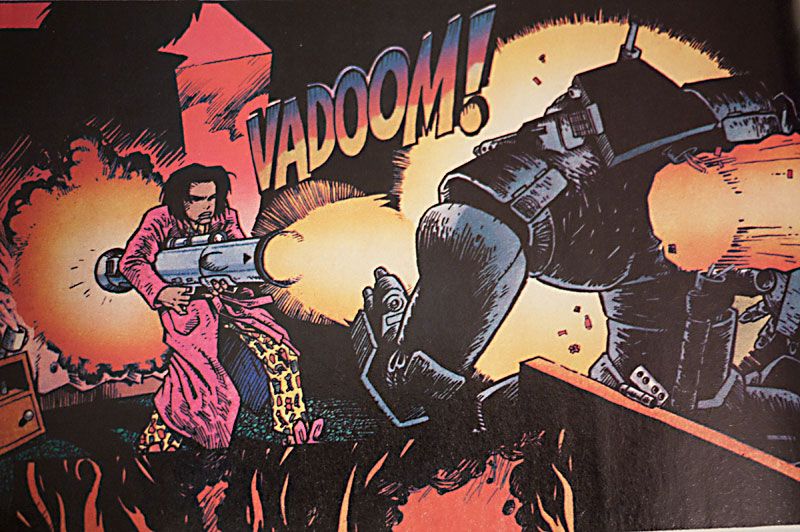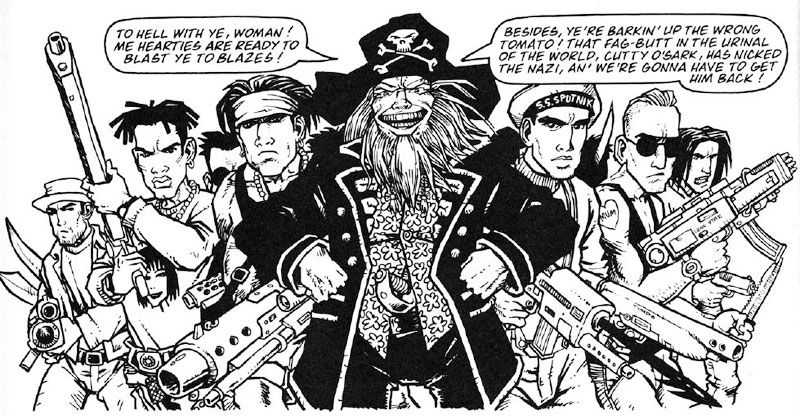Recently I had the very good luck to get my hands on a copy of the Garth Ennis and Phillip Bond 2000AD series; Time Flies. After years of searching for back issues, a friend who collects 2000AD gave me a "spare" copy of 2000AD Extreme Edition #19, which compiles the entire series. It isn't that I'm any kind of fanatic for time travel stories (though I do like science fiction), but more that I adore Bond's art and Ennis's writing. For a long time I've been wanting to check out this early work of theirs, and I was very excited to see how the two would collaborate.
Time Flies comprises of two separate stories; Time Flies (from 1990) and Tempus Fugitive (from 1996.) With the first story being written very early in Ennis' career, you would expect it to be sillier and more ridiculous than the first, but in many ways it is the more structured of the two rather silly stories. The plot is simple, (sort of.) The Time Investigation Team (or T.I.T. as they're called, which sets the tone right away) have travelled back in time from 3584 to 1945 to rescue Herman Goering from time pirates. They've lost their pilot, so the team leader (a female action hero called "Trace", short for Tracer Bullet) recruits a crashed second world war squadron leader; Bertie Sharp, to fly their time machine (which looks exactly like a big, dirty, digging excavator.) The time pirates have a time machine too, it looks like the Tardis, inside and out, which makes sense. Eventually they all band together (sort of) to go up against the big bad; Cutty O'Sark, a character we know is evil because throughout the first story he carries a massive "mobile" phone. In the second story - Tempus Fugitive - O'Sark is resurrected as a zombie version of himself, and our heroes Trace and Bertie team up again to defeat his efforts to destroy and rule reality.
It seems unlikely to me now, but apparently, back in 1990 Ennis was a bit adorable. Far less bitter and far more amused by the stupidity of the world, which I can relate to a little more. Basically, he was a much more of the normal level of grouchily pissed of with the world than he seems to be these days. Nowadays his vitriolic depictions of the powerful and ignorant are terrifyingly intense, his hatred is tangible and slightly disturbing. But with Time Flies, for the most part, Ennis and Bond reserved their most damning little digs for the more annoying aspects of popular culture. In the first story, the side story of the boy band duo who are the crew of the time ship "Prat and Puke Gloss" are the main target. This is a thinly veiled caricature of Luke and Matt Goss, and their bass player. I'm hazy on the details of the real band myself since I didn't like them either, but they were called Bros. If you did have the misfortune to live in the UK at that time, these singers (who looked like "an advert for aryan supremacy and shaves with a facecloth," as Ennis puts it) were everywhere. Clearly it irked Ennis enough that he wrote them into his story in the form of these two vain and pointless characters.
This might seem like a strange detail to focus on, but it is important that Ennis used them as a running joke throughout the first storyline of Time Flies. By doing so, he created a very current, pretty universal joke, that kept things very light. In the second book his targets are more diverse, and his main deconstruction is of the medium itself, having characters slice and cut through the actual art of the comic book. It is something like what Deadpool has become known for now. The silly, off-hand humor and odd little intimations to the readers are one of the mainstays of Time Flies. Both stories make great use of Bond's quintessential style, roughly quirky with incredibly descriptive, highly emotive facial expressions. He takes great delight in depicting exploding ships, gun battles, fast food planets (actually made of fast food) and every form of ludicrous melodrama Ennis can come up with. It is all extremely sweet and funny.
The second Time Flies story - Tempus Fugitive - follows right on from the first, but this time there is color, and what color it is. Personally, I usually prefer black and white comic books, but at least in the first 5 chapters, the color is so well done that it mades me like it. I have no idea if I'm looking at some hand coloring or some crazy computer skills, but however he did it, Simon Jacobs did a bloody nice job. Lots of detail and plenty of definition, with nothing that screws with the art, only adds to it. Bond's are works very well with Jacobs' bold color choices.
On the last 4 chapters of Tempus Fugitive, John Beeston and Roger Langridge take over on the art and the difference is pretty distinct. While Beeston's art is good, the detail doesn't stand up to the stresses of the heavily inked printing and much definition is lost in a regrettable muddiness. Langridge's classic humor is evident in every panel, and while his bold, graphical style is more robust in the face of the saturated colors and heavy black ink, his art is even more obviously different from Bond's. While I like both of their styles, I don't like the discordant continuity of throwing in new artists so close to the end of the story. It makes me feel less invested in the characters. Although this is a lightweight sort of a comic book and isn't the sort of story you expect to feel invested in, it isn't great in this context. However, I did still enjoy seeing a some early Langridge, and I could see hints of the style that has made him so good on books like the Muppet Show comic book. Here he exhibits the same pop art sensibility and stylized gestures which usually work so well for him, but it is so strange in contrast to the previous chapters depicted in Bond's gentle humor. However, it wouldn't be the first time Ennis has had an artist switch up mid-story and at least in this instance it is a man with great talent.
What I came away from this with, was a bit of a yearning to see Ennis return to a more affectionate humor in his books. There is a difference between gentle derision and gross-out, angry mockery, and lately he's moved into the latter camp. Please don't get me wrong, I do enjoy both of his takes on the world, but I honestly had no idea he was capable of writing something so playful and sweet and I enjoyed it. Simultaneously, I very much enjoyed reading a funny story drawn by Philip Bond, he's very, very good at humor. With the strange addition of Langridge, who has become an award-winning writer in the intervening years, I've decided that what I'd like next is to see them collaborate on a comic book someday soon.




